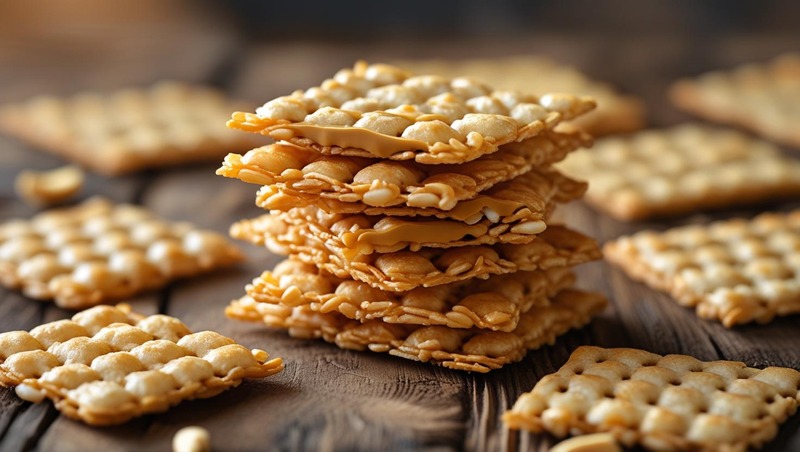Ever crave a snack that’s crispy, protein-packed, and irresistibly delicious? Peanut butter rice crackers might just be your next go-to treat. Whether you’re looking for a quick energy boost, a gluten-free alternative, or just a satisfying crunch, these little bites deliver on taste and nutrition.
In this article, we’ll explore:
✔ What makes peanut butter rice crackers so good (hint: it’s not just the taste!)
✔ How to make them at home (easy, customizable recipes)
✔ Store-bought vs. homemade—which is better?
✔ Creative ways to enjoy them (beyond plain snacking)
Let’s dive in!
Why Peanut Butter Rice Crackers Are a Snack Superstar
1. Perfect Balance of Crunch and Creaminess
Rice crackers are light and crispy, while peanut butter adds a rich, creamy contrast. This combo satisfies both texture and flavor cravings in one bite.
2. Packed with Protein & Healthy Fats
Peanut butter is a great source of plant-based protein (about 7g per 2 tbsp) and heart-healthy monounsaturated fats. Paired with rice (a low-calorie carb), it makes for a balanced snack that keeps you full longer.
3. Gluten-Free & Vegan-Friendly
Most rice crackers are naturally gluten-free, making them a safe choice for those with sensitivities. Pair them with natural peanut butter (no additives), and you’ve got a vegan-friendly snack.
4. Quick Energy for Busy Days
Need a pre-workout boost or an afternoon pick-me-up? The carbs in rice crackers provide fast energy, while peanut butter offers sustained fuel.
How to Make Peanut Butter Rice Crackers at Home
Skip the store-bought versions (often loaded with sugar and preservatives) and try this simple, customizable recipe.
Basic Homemade Peanut Butter Rice Crackers
(Makes about 20 crackers)
Ingredients:
-
1 cup rice flour (brown or white)
-
¼ cup natural peanut butter (unsweetened)
-
2 tbsp water (adjust as needed)
-
½ tsp salt
-
1 tsp honey or maple syrup (optional for sweetness)
-
1 tbsp sesame seeds or chia seeds (optional for crunch)
Instructions:
-
Mix the dough – Combine rice flour, peanut butter, salt, and sweetener (if using). Gradually add water until a firm dough forms.
-
Roll it thin – Place dough between two sheets of parchment paper and roll to ⅛-inch thickness.
-
Cut into shapes – Use a knife or cookie cutter to make squares or circles.
-
Bake – Preheat oven to 350°F (175°C). Bake for 12–15 minutes until golden and crisp.
-
Cool & enjoy! – Let them cool completely for maximum crunch.
Pro Tip: For extra flavor, sprinkle with cinnamon, chili powder, or a drizzle of dark chocolate after baking.
Store-Bought vs. Homemade: Which Wins?
✔ Store-Bought Pros:
-
Convenient for on-the-go snacking.
-
Wide variety (e.g., Quaker, Lundberg, Asian-style rice crackers).
✖ Store-Bought Cons:
-
Often contain added sugars, oils, and preservatives.
-
Less fresh and customizable.
✔ Homemade Pros:
-
Full control over ingredients (organic, sugar-free, etc.).
-
Fresher, crispier, and more flavorful.
Verdict: If you have 20 minutes, homemade is the way to go! Otherwise, opt for brands with minimal ingredients.
5 Creative Ways to Enjoy Peanut Butter Rice Crackers
-
Top with Banana Slices – A classic combo for a sweet, filling snack.
-
Make a Mini Sandwich – Add a dab of jelly or honey for a PB&J twist.
-
Dip in Yogurt – Greek yogurt + crushed crackers = protein-packed crunch.
-
Crush Over Ice Cream – Adds texture to vanilla or chocolate scoops.
-
Trail Mix Upgrade – Break into pieces and mix with nuts and dark chocolate chips.
Final Thoughts: Are Peanut Butter Rice Crackers Worth the Hype?
Absolutely! They’re:
✅ Easy to make (even for beginners)
✅ Nutritious (protein, fiber, healthy fats)
✅ Versatile (sweet or savory, snack or meal topper)
Next time hunger strikes, skip the chips and grab (or make) peanut butter rice crackers instead. Your taste buds—and body—will thank you!










